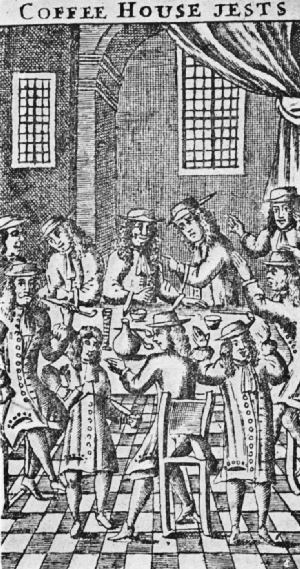London Coffee-Houses
 The largest coffee-house franchise in the world
The largest coffee-house franchise in the world
(founded in 1971, with 17,133 stores world-wide)
I went to a coffee house this morning. I had a ‘grande’ latte. It cost me $3.20. Sometimes I carry the coffee with me to work in a cardboard cup; this time I sat in the coffee house and drank it while reading the newspaper. I went by myself and did not have a conversation with any of the other customers – several of whom I vaguely recognised but most of whom were strangers. Almost all of them were talking to someone they had come with, reading their own papers, or doing something on the internet, as this coffee house is a wireless hot spot.
Here are some other things I didn’t do at the coffee house: I did not hear a philosophical or scientific lecture, though I inadvertently picked up fragments of talk about accountancy reform and recent appointments to the Supreme Court – this coffee house is adjacent to Harvard’s Kennedy School of Government and across the Charles River from the Business School. I did not take part in a political cabal, or think that one was being plotted around me, unless the normal conversation of Harvard elites counts as such. It did not occur to me that any of the discussions taking place might be reported to George W. Bush or the FBI – though one can never be too sure of that these days. If there had been an attempt by the Bush regime to ban this coffee house as a hotbed of sedition, or to send agents to spy on its clientele, I had not heard of it. I did not witness the dissection of a dolphin, the display of an elephant or a rhinoceros, or an exhibition of a child with three penises and a woman with three breasts. I did not hear customers sing an eight-part canon; I did not take a bath, gamble with dice or secure the services of a prostitute. A fellow customer did not offer to sell me shares in a publicly traded company or insurance on my life or property, and I did not buy books, paintings or whale oil at a candle auction. The clientele was fairly specific to the neighbourhood and so not very heterogeneous, and, if the neighbourhood did not make it socially pretty samey, then the outrageous price of the latte did. No one was smoking – it’s banned – and many of the customers were women.
All of this makes the coffee house I go to a very different sort of place from those that proliferated in London from the middle of the 17th century; but despite these marked dissimilarities, social and cultural theorists have placed a heavy bet on early coffee houses as crucibles of modernity. It started with Habermas, who in The Structural Transformation of the Public Sphere (1962) argued for their importance in the rise of the ‘bourgeois public sphere’. What was said to be pertinent about the hundreds of coffee houses jostling for customers in late 17th and early 18th-century London was, first, the social diversity of their customers; second, the temporary setting aside of distinctions of social rank; third, the common conversation in which their customers were swept up; fourth, the circulation of print, and especially of printed news, in the place where this jumble of people were talking about it; and, fifth, the occasional closing of the circle through the embodying of coffee-house talk in new forms of print which could then become the objects of still more coffee-house talk.
[Excerpt from Steven Shapin, “At the Amsterdam,” in The London Review of Books (20 April 2006), pp. 12-13.]
[The woodcut and handbill are reproduced from William H. Ukers, All About Coffee (New York: The Tea and Coffee Trade Journal Company, 1922), pp. 55, 62]

.jpg)